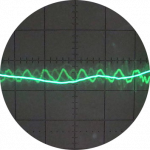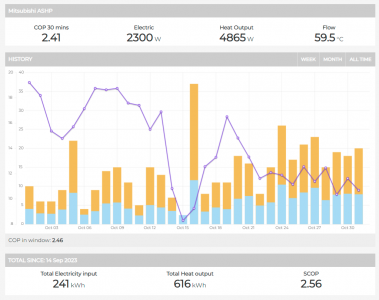Posted by: @fazelThat's why I've posted the link of the system with the date in the picture.
This is exactly what I get when I click on the link, and it (it is everything on the screen) still has all the problems I mentioned:
No labels/units on the Y axis, no legend, you have to work out the dates by assuming it must/might be Oct 2023 because it may or may not be the case the counting started on 14 Sep 2023. Surely it is not that hard to add the year, why not do it, so someone looking at a screengrab from 2022 in 2026 knows they are looking 2022 data? Of the numbers at the top, only the COP has any context, it is a 30 min COP. But the other numbers? Instantaneous readings? Why is flow, which is normally given in volume or speed over time units (eg litres per minute) measured in degrees Celsius? Something seems to have happened on 15/16th Oct (this year? last year?) - context? Or is it just an artefact, two days readings rolled into one? And so on.
Please don't think I am having a go at you, because I am not, what I am doing is having a go (constructive, all the above also amount to suggestions, to correct the ommissions) at what I consider to be a very good example of bad charting.
Midea 14kW (for now...) ASHP heating both building and DHW
Hi folks,
I've been following this discussion with interest. We've had our Vaillant AroTherm 12kW up and running for a week now, and I've been conducting a few experiments. I've been gradually winding down the heat curve (currently at 0.55, down from the installer's 0.75), but I've noticed that (in the downstairs zone in particular) is starting to struggle to recover from even a very small (2 or even 1°C) overnight setback (it gets there, and will happily maintain temperature after that, it just takes ages). So, the options for a slightly warmer downstairs at wake-up time would appear to be:
- Put the heat curve back up a little;
- Start setback recovery earlier;
- Just run it constantly overnight.
So here's the question: our system has weather compensation and room compensation for the two zones (downstairs/upstairs), so, given that it is modulating the temperature anyway, is there likely to be much of an efficiency deficit to bumping the heat curve back up again for better setback recovery? I.e. does the combination of weather and room compensation help to reduce setback recovery inefficiencies?
(Or is this just exactly the same as the question being investigated in this thread?)
Enjoying the hardware so far, but using Vaillant's sensoAPP is like having one hand tied behind your back - so much useful info which is clearly there, but inaccessible! My engineering side is itching to get as bunch of sensors on everything to understand what's going on.
Interested to hear your thoughts.
Cheers,
Jo
Posted by: @josephiahOr is this just exactly the same as the question being investigated in this thread?
Pretty much so, I think the core question is: do the savings made during a setback amount to more or less than the extra costs incurred (because of lowered efficiency and higher LWT, ie there is a double hit, higher LWT needs more energy anyway, and that higher LST also lowers efficiency) during a post setback recovery boost. The modellers are determined to settle this question using models, in much the same way that alchemists sought to turn base metals into gold by using dark magic, but my own inclination is that the only satisfactory answer will be an empirical one, even if such an approach has the problem that no two days are the same, in other words, I can't do a controlled experiment, instead I have to rely on observations.
At the moment it is still very mild here, and my heat pump is dozing (cycling, but that is OK, it is the only way it can reduce output) much of the time, so not really a good time to make comparisons. Sustained sub 10 degrees C OAT temperatures and especially the 0 to 5 degree range when defrosts kick in is when things will start to get interesting.
Midea 14kW (for now...) ASHP heating both building and DHW
Personally going totally against the grain here but i have now set a fixed temp of 30degrees and im running for 6 hours from mid afternoon to 8pm. So far my house the following mornings have been still warm at 21. Derek m calculations showed me im getting good cop so plenty thermal energy going to the slab and house is retaining heat well. Me or the girlfriend aren't in the house usually until evening time so by turning on at2pm its nice and warm when we get home and until we go to bed. OAT approx. 6 last night but house only dropped 1 degree over night as i presume all the thermal energy sent to slab was still releasing most of the night. I chose 30 as when i had my curve approx 29/30 @9deg OAT was giving comfortable temps and not over heating. I went off wc for an experiment as using maybe poor logic, the wc doesn't know how quick my house heats up or retains heat, i have a better idea of that. If 30lwt still warms house in colder weather i will have big savings compared to last winter. Generally using just below 2kwh electricity per hour but with cop near 5 or above that means lots of energy to the slab. LWt of 27 in mild weather cycled alot and took ages to warm up house. Also opening all my house to 1 zone has massively increased comfort levels especially in hallway which used be cold and improved cop alot i think. I will report back in colder weather. Think houses are unique, some dont suit 24hour running, no way would running 24hours for me be cheaper then running for 6 but time will tell with cold weather if my fixed flow works.
Posted by: @cathoderayPretty much so, I think the core question is: do the savings made during a setback amount to more or less than the extra costs incurred (because of lowered efficiency and higher LWT, ie there is a double hit, higher LWT needs more energy anyway, and that higher LST also lowers efficiency) during a post setback recovery boost.
For my system, the issue with a setback isn't so much the LWT, it's the delta between the LWT and RWT: the compressor runs a lot harder in the warmup phase after the setback ends and the RWT is around 20/21 and getting it up to 28 or higher, power consumption spikes hugely if the outside temp is below about 4C and all the economies of the setback are quickly lost. Perhaps the issue is that a setback strategy works ok in milder weather, but as the temp drops it becomes a lot more questionable: one strategy doesn't suit all conditions.
Posted by: @josephiahHi folks,
I've been following this discussion with interest. We've had our Vaillant AroTherm 12kW up and running for a week now, and I've been conducting a few experiments. I've been gradually winding down the heat curve (currently at 0.55, down from the installer's 0.75), but I've noticed that (in the downstairs zone in particular) is starting to struggle to recover from even a very small (2 or even 1°C) overnight setback (it gets there, and will happily maintain temperature after that, it just takes ages). So, the options for a slightly warmer downstairs at wake-up time would appear to be:
- Put the heat curve back up a little;
- Start setback recovery earlier;
- Just run it constantly overnight.
So here's the question: our system has weather compensation and room compensation for the two zones (downstairs/upstairs), so, given that it is modulating the temperature anyway, is there likely to be much of an efficiency deficit to bumping the heat curve back up again for better setback recovery? I.e. does the combination of weather and room compensation help to reduce setback recovery inefficiencies?
(Or is this just exactly the same as the question being investigated in this thread?)
Enjoying the hardware so far, but using Vaillant's sensoAPP is like having one hand tied behind your back - so much useful info which is clearly there, but inaccessible! My engineering side is itching to get as bunch of sensors on everything to understand what's going on.
Interested to hear your thoughts.
Cheers,
Jo
Based upon modelling, and the Laws of Physics and Thermodynamics, reducing the Indoor Air Temperature (IAT) will indeed reduce heat loss, which in turn will reduce the quantity of electrical energy required to operate a heat pump. The quantity of electrical energy saved is dependent on a number of factors, the degree by which IAT is allowed to fall, the time period over which this reduction occurs, variations in Outside Air Temperature (OAT), the thermal mass of the home, the heat loss calculation and the heating capacity of the heat emitters.
Reducing the IAT from 20C to 19C @ an OAT of 15C could theoretically reduce electrical energy consumption in the order of 20%. The saving with a similar reduction @ an OAT of 0C would be in the order of 5%. The actual kWh reduction would obviously be greater at 0C, since the heat pump would be working much harder.
So saving electrical energy and hence cost, is just a matter of reducing the required IAT.
Of course this works fine until you wish to raise the IAT, since it is now necessary to replace some of the thermal energy that has been saved.
Replacing the lost thermal energy requires the heat pump to produced more thermal energy than that required just to satisfy the present heat loss, which means it has to work harder and increase the Leaving Water Temperature (LWT). The rate at which the IAT increases is therefore dependent upon how much excess energy the heat pump is producing, which in turn dictates how efficient the heat pump is operating. Increasing the IAT faster, requires the heat pump to work much harder, which in turn reduces its efficiency, often when the OAT is quite low which has already reduced the heat pump efficiency. This can be a double whammy (technical term), which can not just negate any electrical energy savings that have been made, but could potentially increase overall energy consumption.
For best overall electrical energy reduction, any setback should be carried out when the OAT is at its lowest, with slow recovery being performed when OAT is at its highest. Unfortunately this does not always coincide with the home occupants lifestyle.
As you say, 'no two homes are the same'.
As CathodeRay will delight in saying 'you can model to your hearts content, but you cannot beat physical testing', with which I fully agree. Having said that, modelling does allow different options to be explored, to decide which may be the better ones to try.
Please let us know what happens when the cold weather arrives.
Posted by: @rodPosted by: @cathoderayPretty much so, I think the core question is: do the savings made during a setback amount to more or less than the extra costs incurred (because of lowered efficiency and higher LWT, ie there is a double hit, higher LWT needs more energy anyway, and that higher LST also lowers efficiency) during a post setback recovery boost.
For my system, the issue with a setback isn't so much the LWT, it's the delta between the LWT and RWT: the compressor runs a lot harder in the warmup phase after the setback ends and the RWT is around 20/21 and getting it up to 28 or higher, power consumption spikes hugely if the outside temp is below about 4C and all the economies of the setback are quickly lost. Perhaps the issue is that a setback strategy works ok in milder weather, but as the temp drops it becomes a lot more questionable: one strategy doesn't suit all conditions.
Maximum electrical energy reduction would require setback to be performed during the lowest OAT, with slow recovery being carried out during the highest OAT. Of course this does not always coincide with peoples lifestyle.
An alternative would be to boost during the warmer OAT period and then lower IAT during the remaining period.
Posted by: @rodPerhaps the issue is that a setback strategy works ok in milder weather, but as the temp drops it becomes a lot more questionable: one strategy doesn't suit all conditions.
I think you may well have a good point here, particularly when the OAT gets into the defrost range. I will be doing some experiments once we have colder weather.
Midea 14kW (for now...) ASHP heating both building and DHW
Thanks for the comments and explanations everyone. The observation about running hard to recover the lost energy fits with what I'm seeing (from basic hourly consumption data in my HP's app, rather than separate monitoring). Need to chart it out properly, but just from roughly eyeballing the charts it does look to me that the recovery even from 19°C to 20°C over the last few chilly nights has tended to create a larger 'hill' on the consumption graph compared to the setback 'valley' preceding it. But the point about the possibility of different strategies suiting at different OATs is well made.
(Tonight and the next few are looking a bit warmer - good for the heating, less good for comparable experiments!)
Hi James,
I have now completed a WC version of the modelling tool, which I think works quite well.
If you have the time and inclination, I would appreciate you checking it out and trying to 'break' it.
I can explain the assumptions behind the formula's if required.
You may also be interested Kev since it is based upon your system.
- 26 Forums
- 2,342 Topics
- 53 K Posts
- 159 Online
- 6,000 Members
Join Us!
Worth Watching
Latest Posts
-

RE: Are We Sleepwalking Into Another Race to the Bottom?
…otherwise known as “hive got news for you”. And don’...
By Majordennisbloodnok , 6 hours ago
-
RE: Configuring third party dongle for Ecodan local control
Logically, I'll fall into that category so the natural ...
By Sheriff Fatman , 6 hours ago
-

RE: Controlling Daikin Altherma via P1P2 and Home Assistant
I haven’t got a Daikin but I have been having some fun ...
By Majordennisbloodnok , 6 hours ago
-

RE: Setback savings - fact or fiction?
@robs — thanks again for your detailed comments. Some r...
By cathodeRay , 9 hours ago
-
RE: Free Ecoheat Heat Pump Install
I don't mind thread drift, it's how conversation natura...
By Deltona , 10 hours ago
-

RE: A Smarter Smart Controller from Homely?
@papahuhu I hope you get a swift resolution. Regards, T...
By Toodles , 12 hours ago
-

RE: Poll for Time of Use, tariffs, technology
That’s fine by me too Major, I feel it is a sad reflect...
By Toodles , 14 hours ago
-

Bingo. Sometimes a judiciously placed size 10 bovver bo...
By Majordennisbloodnok , 14 hours ago
-
RE: Mitsubishi Ecodan 11.2kW heat pump with low COP
@ciocoiu-alexandru I can't provide the same level of di...
By Sheriff Fatman , 14 hours ago
-
RE: Octopus Cosy Heat Pump Owners & Discussion Thread
Recently had my follow up with octopus for the vibratio...
By swwils , 16 hours ago
-

The three technical issues I'm considering are: BMS...
By Transparent , 17 hours ago
-
RE: LiFePO4 lithium battery fires and explosions
@transparent Your post may fit better in th...
By Batpred , 17 hours ago
-

RE: British Gas vs Octopus Energy vs Heat Geek vs EDF vs Aira vs OVO vs EON.Next vs Boxt
@jamespawhite, if you could be bothered, you could also...
By Mars , 19 hours ago
-
RE: Commencing on an ASHP Installation Process
I've got a bit of time to draft something today, so the...
By Sheriff Fatman , 1 day ago
-
RE: Help with heat pump sizing
@amin I dont think materially relative to t...
By JamesPa , 2 days ago
-

@majordennisbloodnok I have decided to take the plunge....
By TechnoGeek , 2 days ago
-
RE: Different dT on each radiator?
I cant sorry. Its based on some calculations I did fro...
By JamesPa , 2 days ago
-
RE: Help me keep the faith with my air source heat pump installation
@simonf thats interesting as I’ve noticed my flow and r...
By AdamK , 3 days ago




